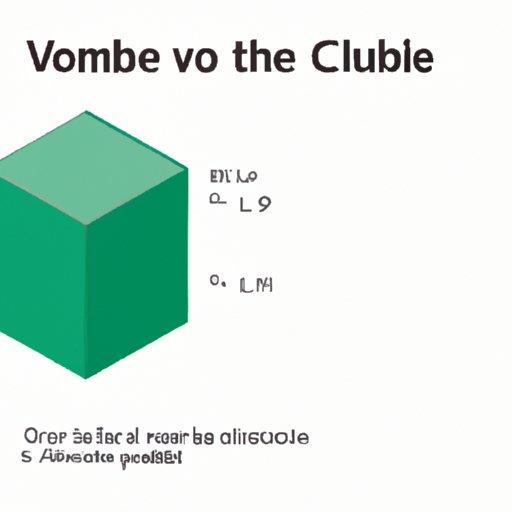
Introduction
Understanding how to find the volume of a cube is one of the foundational concepts in math and science. It helps to measure the amount of space a cube takes up and is used in various fields such as construction, packaging, shipping, and more. In this article, we will cover multiple approaches for calculating the volume of a cube, ranging from a step-by-step guide with pictures to interactive methods and video tutorials with real-life examples.
Step-by-Step Guide Method
A cube is a three-dimensional shape with six congruent square faces. In other words, all the sides of the cube are of equal length. To calculate the volume of a cube, we need to measure its length, width, and height. The formula to calculate the volume of a cube is:
V = l x w x h
where V is the volume, l is the length, w is the width, and h is the height of the cube.
Here are the steps to follow to measure the volume of a cube:
- Measure the length of a side of the cube.
- Multiply the length by itself to get the area of one face.
- Multiply the area by 6 to get the area of all six faces.
- The resulting value is the volume of the cube.
Let’s take an example to understand the steps better:
Consider a cube with a side length of 5 cm. Using the formula, we can calculate the volume as follows:
V = 5 x 5 x 5 = 125 cubic centimeters
Therefore, the volume of the cube is 125 cubic centimeters.
It is important to note that the units used to measure the length, width, and height of the cube should be the same as the unit used for measuring the volume. Also, make sure to measure all three dimensions accurately to get the correct volume of the cube.
Real-World Application Approach
The volume of a cube is an important concept in various real-world applications such as construction, packaging, shipping, and more. Let’s explore some examples:
- Construction: Architects and builders use the volume calculation of cubes to determine how much material is required to build a structure. For example, they need to know the number of cubic meters of concrete, steel, or lumber required to construct a building.
- Packaging: Companies use the volume calculation of cubes to determine the size and shape of the packages they need to use for their products. This information helps in optimizing the space, reducing the cost of shipping, and keeping the products safe during transit.
- Shipping: The volume calculation of cubes is also used in the shipping industry to determine how much cargo a container can hold and how many containers can fit in a ship or truck.
Understanding the volume of a cube is essential in these practical scenarios, making it an important concept to learn.
Interactive Methods
Learning how to calculate the volume of a cube can be made more engaging and interactive by using different approaches:
- Quizzes: Add quizzes to the article to test the reader’s understanding of the content. This can also help retain information better by recalling what was learned previously.
- Interactive Images: Add interactive images to illustrate the process of finding the volume of a cube. Readers can select or drag different parameters to see the effect on the final volume.
- Animations: Add animations to explain the concepts better. For example, an animation can show the process of multiplying the area of one face by 6 to get the total area.
All these interactive elements make the learning process more fun and engaging, allowing readers to understand the concept better.
Graphical Representation
Using diagrams and graphics to illustrate the process of finding the volume of a cube makes it easier to understand. Here is how we can represent it:
- Draw a cube with each side labeled as “a”.
- Calculate the area of one face as “a x a”.
- Multiply the area by 6 to get the total area.
- The resulting value is the volume of the cube as “a x a x a”.
Here’s a diagram to illustrate these steps:

We can also use tables to help readers determine the volume of a cube easily. Here’s an example:
| Side Length | Area of One Face | Total Area | Volume |
|---|---|---|---|
| 1 cm | 1 cm^2 | 6 cm^2 | 1 cm^3 |
| 2 cm | 4 cm^2 | 24 cm^2 | 8 cm^3 |
| 3 cm | 9 cm^2 | 54 cm^2 | 27 cm^3 |
This table shows the relationship between the side length, area of one face, total area, and volume of a cube for different side lengths. It can help readers understand how the calculations are made and determine the cube’s volume quickly.
Video Tutorial
Another approach to learn how to find the volume of a cube is by watching a video tutorial. Videos provide an engaging way to learn and understand complex concepts better. Here’s an example:
This video shows a visual example of a cube being filled with water, with the volume being calculated based on the amount of water displaced.
Conclusion
Learning how to calculate the volume of a cube may seem like a simple concept, but it has a wide range of applications in real-world scenarios. In this article, we have covered multiple approaches, including a step-by-step guide, real-world applications, interactive methods, graphical representations, and video tutorials. It’s essential to understand the cube’s properties and dimensions and measure them accurately to calculate the volume. We encourage readers to try the different methods and figure out what works best for them.




